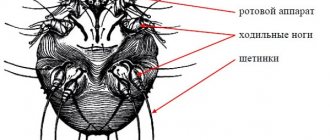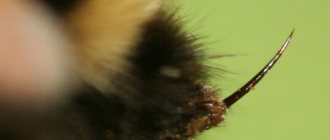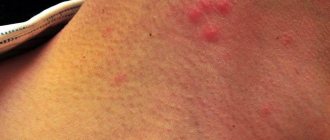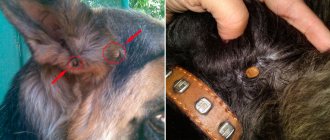First aid for a tick bite
A tick bite is a dangerous problem that can lead to severe illness and death. The likelihood of a parasite attack increases during the warm season. It is in late spring, summer and early autumn that patients with suspected encephalitis, borreliosis and inflammatory processes peak in visiting medical clinics.
Only the correct algorithm of actions, pre-prepared preventive measures and rejection of untested folk remedies will help the patient reduce the risk of disease transmission. But when bitten, it is very high, especially if the parasite bit in a region where outbreaks of encephalitis are often observed.
Before you think about treating a bite site, you need to get reliable information about the signs of a bite and treatment methods. Experts report that the bite may not be noticeable at first. The parasite releases saliva containing anesthetic substances into the victim's blood. They eliminate pain, and for a long time, until the onset of inflammation, the patient may not feel discomfort. It's better to rely on other symptoms:
- feeling of weakness;
- heat;
- aching joints;
- loss of appetite;
- drowsiness.
Patients with hypersensitivity at the site of the bite may develop dermatitis. Most often, after a tick infestation, a lump appears with a dark dot in the middle (if the parasite has already fallen off). If the insect continues to drink blood, you can notice it by its swollen abdomen, similar to a large pea.
Wow, a tick has sucked in!
In the spring and summer, miniature blood-sucking parasites become active in the vast forest expanses of our country. “Close acquaintance” with them can be both a minor nuisance and a serious problem, sometimes threatening health and even life. What to do if you are bitten by a tick, and how dangerous is it?
We met strangely...
Where the lush, tall grass is green, you just want to lie down and deeply breathe in the heady aroma of summer. But there’s no need to rush: on forest edges, along the banks of rivers and lakes, in meadows overgrown with ferns, there live ticks that can’t wait for you... to have lunch.
It’s not every day that these arthropods have the joy of finding food: ticks cannot jump or fly, and they move with great difficulty, covering no more than 10 meters in their entire life. But if the parasite is finally lucky and a person passes in close proximity to it, then it will not miss its target.
What can you do at home?
A tick has attached itself: what to do to avoid negative consequences? Infectious disease specialists recommend immediately going to a medical clinic to have the parasite checked. Specialists will examine him and find out whether he could have suffered any disease.
Even before going to the doctor, the insect is removed. This reduces the likelihood of viral infection. This phenomenon is explained by the fact that some diseases are transmitted not through saliva, but through tick feces (Lyme disease). The sooner you remove an insect from your skin, the lower the risk that it will infect a person with one of the dangerous infections.
You need to pull out the tick by grasping the head with tweezers or a special device for removing ticks. You cannot jerk your hand sharply. Using light circular movements you need to unscrew the parasite like a screw. After this, be sure to place it in a jar or test tube and send it for analysis. You must not squeeze the abdomen, tear the body away from the head, or leave the head of the insect and its proboscis under the skin.
If you cannot pull out the parasite, you should not use oil or alcohol to suffocate it. A common misconception is that a tick will crawl out when it feels short of air, leading to an increased risk of infection. The patient applies oil to the bite site, and the parasite, suffocating, dies and releases even more dangerous substances into the blood. Therefore, if the parasite is stuck, there is no need to try to squeeze it or suffocate it. It is important to treat the wound with a disinfectant and go to the doctor.
If the proboscis remains in the skin, you can try to pry it off with a needle. If unsuccessful, treat the wound with iodine and go to the doctor. The specialist may cut a small area of skin to remove the foreign object.
After the parasite has been submitted for analysis, loved ones need to constantly monitor the condition of the bitten person. Some diseases transmitted through contact with the parasite develop within a few hours. Others may become active only after a few weeks. Therefore, it is very important to record all strange symptoms within 1-1.5 months after the bite. If you have a fever, fever, memory problems, aching joints or unreasonable pain in the heart, you should see a doctor.
What to do if you are bitten by a tick and how to prevent viral encephalitis. Expanded instructions
Author:
gastroenterologist Anton Smirnov
7 minutes
12482
We recently published a major piece on the current tick season and the diseases they carry. In connection with updated information about the foci of tick-borne viral encephalitis (TBE) in Moscow, Mednovosti provides detailed instructions on what to do if you are bitten by a tick.
According to the April report of the Research Institute of Epidemiology of Rospotrebnadzor, which is cited by Izvestia, a cluster of TVE was discovered in the city of Moscow. Epidemiologists refer to data from last year’s studies that discovered ticks and mammals infected with TVE in the Krylatsky Forest Park. In 2021, one victim, bitten by an encephalitis tick, contacted the research institute; another person ended up in the hospital a year earlier. Experts point out that these were the first cases of detection of the virus in the city. They warn residents of the capital that the situation could repeat itself this year.
It was previously reported that last year 13,332 people (2,699 of them children) visited medical institutions in the capital alone due to tick bites. This year, in 70 constituent entities of the federation, about four thousand victims, including 1,591 children, contacted medical organizations, which is below average.
Here are recommendations on what to do if you find a tick on yourself, taken from the leaflet “Beware of Ticks,” compiled by the chief freelance specialist in infectious diseases of the Ministry of Health of the Russian Federation, Professor I.V. Shestakova.
Removing the tick
Contact the specialists
If tick suction does occur, an initial consultation can always be obtained by calling a landline number: 103, or from a mobile (cell) phone: 103* or 112.
A person who has suffered from a tick bite must seek medical help from the territorial clinic at his place of residence, the regional SES or the regional emergency room to remove the tick and deliver it for examination, as well as to organize medical observation, in order to make a timely diagnosis of tick-borne infection and resolve the question of prescribing preventive treatment.
If for some reason you do not have the opportunity to seek help from a medical institution, then you will have to remove the tick yourself, and the sooner you remove the embedded parasite, the better.
Removing ticks yourself There are several ways to remove ticks. They differ only in the tool used to remove the tick. It is most convenient to remove a tick with curved tweezers or a surgical clamp; in principle, any other tweezers will do. In this case, the tick must be grabbed as close to the proboscis as possible, then it is carefully pulled up, while rotating around its axis in a convenient direction. Usually, after 1-3 turns, the entire tick is removed along with the proboscis. If you try to pull the tick out, there is a high probability of it breaking.
If you have neither tweezers nor special devices for removing ticks at hand, then the tick can be removed using a thread. A strong thread is tied into a knot as close as possible to the tick's proboscis, then the tick is removed, slowly shaking it to the sides and pulling it up. Sudden movements are not allowed.
If you don’t have tweezers or thread at hand, you should grab the tick with your fingers (it’s better to wrap your fingers in a clean bandage) as close to the skin as possible. Pull the tick slightly and rotate it around its axis. There is no need to crush the tick with your hands. After removing a tick, be sure to wash your hands. The wound must be treated at home with an antiseptic.
Removing a tick must be done with care, without squeezing its body, since this may squeeze the contents of the tick along with pathogens into the wound. It is important not to tear the tick when removing it - the remaining part in the skin can cause inflammation and suppuration. It is worth considering that when the head of the tick is torn off, the infection process can continue, since a significant concentration of the tick-borne encephalitis virus is present in the salivary glands and ducts.
If, when removing the tick, its head, which looks like a black dot, comes off, wipe the suction site with cotton wool or a bandage moistened with alcohol, and then remove the head with a sterile needle (previously calcined in a fire) in the same way as you remove an ordinary splinter.
After removing the tick After removing the tick, the skin at the site of its attachment is treated with tincture of iodine or alcohol, or another available skin antiseptic. A bandage is usually not required. Subsequently, the wound is treated with iodine until healing. There is no need to pour in a lot of iodine, as it can burn the skin. If everything is normal, the wound will heal within a week. Hands and tools should be thoroughly washed after removing the tick.
When removing a tick you do not need to:
- apply caustic liquids (ammonia, gasoline, etc.) to the bite site;
- burn a tick with a cigarette; - jerk the tick sharply - it will break off;
- picking at the wound with a dirty needle;
- apply various compresses to the bite site;
- crush the tick with your fingers.
There is no basis for some far-fetched advice that for better removal one should apply ointment dressings to the attached tick or use oil solutions. The oil can clog the tick's breathing holes, and the tick will die while remaining in the skin. Dripping oil, kerosene onto a tick, or burning the tick is pointless and dangerous. The tick's respiratory organs will become clogged, and the tick will regurgitate the contents, increasing the risk of infection.
We send the removed tick for examination
If research is not possible, the tick should be burned or doused with boiling water. The removed tick should be placed in a small hermetically sealed container with a small piece of slightly damp cotton wool or a napkin and sent to the laboratory. The jar with the tick is placed in the refrigerator if it is impossible to transport it to the laboratory immediately after removing the tick. Within two days, the tick must be taken to the laboratory to be tested for tick-borne infections. Usually the analysis can be done in a regional infectious diseases hospital or a special laboratory.
Laboratory addresses
For Moscow residents:
- in the department of especially dangerous infections of the microbiological laboratory of the Federal State Institution "Center for Hygiene and Epidemiology in Moscow" at the address: Moscow, Grafsky lane, 4/9 (entrance from the courtyard, 2nd floor), tel.. Reception is held from 9-00 until 15-30 daily, except Saturday, Sunday and holidays (lunch break from 13-00 to 13-30), the results of research can be found out from 15-00 to 18-00;
- branch of the Federal State Institution "Center for Hygiene and Epidemiology in Moscow" at the address Moscow, Krasnogvardeisky Boulevard, 17 building 1 microbiological laboratory, reception from 9.30 to 15.00 daily, except Saturday and Sunday, tel.;
- Federal Budgetary Institution of Health "Federal Center for Hygiene and Epidemiology of Rospotrebnadzor" in Moscow at the address Varshavskoye Highway 19a (Nagatinskaya metro station) Mon-Fri from 9.00-18.00 tel. +7(495)954-45-36.
Residents of the Moscow region can receive specialized assistance at their place of residence in the Central District Hospital or at the above addresses.
What should a person bitten by an infected tick understand?
It is impossible to judge by the appearance of a tick whether it is a carrier of infection or not. The tick becomes infected when feeding on an infected animal. The virus can be contained in females, males, nymphs, and larvae. Even if the tick bite was short-lived, the risk of contracting tick-borne infections cannot be ruled out.
However, it should be understood that the presence of an infection in a tick does not mean that a person will get sick. A tick analysis is needed for peace of mind in case of a negative result and vigilance in case of a positive result.
It is advisable that a person who has suffered from a tick bite be observed by an infectious disease specialist for a month, who, if necessary, will prescribe the necessary preventive or treatment measures. If more than 2 months have passed since the tick bite, there is no need to worry.
There is no need to self-medicate; if in doubt, consult a doctor! If a tick bite has occurred, if your health worsens, consult a doctor immediately!
We carry out specific prevention (only tick-borne viral encephalitis)
Emergency prevention of tick-borne borreliosis, human monocytic ehrlichiosis and human granulocytic anaplasmosis is usually not carried out.
Tick-borne viral encephalitis is a very dangerous tick-borne infection. Emergency prevention of tick-borne encephalitis should be carried out as early as possible, preferably on the first day. It is carried out using antiviral drugs or immunoglobulin (when virus ticks are sucked on by people who have not been sick or previously vaccinated, as well as those who have an incomplete or defective vaccine course in the first 96 hours after sucking, intramuscularly, once). A doctor carries out preventive measures.
When an encephalitis tick bites, the virus enters the bloodstream with saliva. In the future, events may develop differently. If the bitten person has been vaccinated and the level of antibodies is sufficient, the virus immediately binds and the disease does not develop. The development of tick-borne viral encephalitis can be stopped by other factors of antiviral protection. Therefore, even if the tick was encephalitic, the person bitten may not get sick. The presence of a virus in a tick does not mean that the disease will develop. The number of people bitten by encephalitis ticks significantly exceeds the number of people sick with tick-borne encephalitis. But even one bite can lead to serious illness.
Where to go for emergency prevention against tick-borne encephalitis in Moscow
For adults:
- Infectious Clinical Hospital No. 2 of the Moscow Department of Health, Moscow, 8th st. Sokolinaya Gora, 15. Help service.
- City advisory office on vaccine-serum prevention of tick-borne viral encephalitis: tel., +7(495)365-01-47 (www.mosgorzdrav.ru/ikb2)
For children:
- Children's City Clinical Hospital No. 13 named after. N.F.Filatova, Moscow, st. Sadovaya Kudrinskaya, 15. Help desk: +7(499)254-91-29.
Vaccinations against tick-borne encephalitis
If you frequently visit tick habitats, it is advisable to get vaccinated against tick-borne viral encephalitis. The vaccine protects for at least 3 years. Persons working in endemic areas (foresters, geologists, etc.) and children living in endemic areas are subject to mandatory vaccination.
In Russia, vaccination is carried out with domestic vaccines (Tick-borne encephalitis vaccine, cultural purified concentrated inactivated dry, EnceVir) and foreign vaccines (FSME-Immun Inject/Junior, Encepur adult, Encepur children) or by primary and emergency schemes. All vaccines have the same immunogenicity. Vaccination can be carried out according to two schemes: the main and emergency. The main scheme (0, 1-3, 9-12 months) is carried out with subsequent revaccination every 3-5 years. To form immunity to the onset of an epidemic season, the first dose is administered in the fall, the second in winter. An emergency regimen (two injections with an interval of 14 days) is used for previously unvaccinated persons arriving in endemic foci in the spring and summer. Emergency vaccinated persons are immunized for only one season (immunity develops after 2- 3 weeks), after 9-12 months they are given the 3rd injection.
How to treat a bite site
A tick bite and its treatment at home is a controversial issue. Some experts advise immediately going to the doctor, others say that it is advisable to treat the wound yourself. It would be optimal to first treat the bite site, and then still go for an examination to a specialist.
To stop the spread of infection and viruses, you can use one of the following means:
- chlorhexidine;
- peroxide;
- iodine 5%;
- brilliant green;
- medical alcohol.
Allows the use of regular alcohol, but only if there are no specialized products at hand. For example, vodka will do. Fermented drinks (beer, wine) should never be poured onto the wound.
To prevent dangerous particles from getting into the lump in the future, you should tape it or lightly bandage it when you go to the doctor. After this, the specialist will decide whether it is worth continuing to cover the bite, or whether it is better to let it air dry faster.
Folk remedies are not used for processing. Their use will only worsen the situation and can lead to the development of inflammation.
Bite infection after tick removal
In most cases, parasites are removed independently at home. You can pull out a tick using a thread, tweezers, special devices, or a syringe. Sudden movements are not allowed, since the head comes off and remains under the skin. If the tick is removed incorrectly, a piece of its body remains under the skin, which can lead to inflammation and rotting of the wound.
Methods for removing ticks
After removing the tick, the bite site must be disinfected. All instruments used must be pre-treated with an antiseptic. If these rules are not followed, the wound gets infected, swelling, inflammation, itching, mucus and pus appear. Symptoms develop a few days after tick removal.
The affected area should be smeared with drugs with an antibacterial effect. Local antibiotics are available in the form of ointment, cream, or lotion. Treatment of a meta bite begins with washing the wound with hydrogen peroxide. Remove accumulations of pus, mucus and dirt.
You can treat a tick bite with one of the following medications:
- Vishnevsky ointment;
- Tetracycline ointment;
- Levomekol;
- Elokom S;
- Salicylic ointment.
You can buy medicines at the pharmacy. Cost from 50 rub. up to 500 rub. There are contraindications and age restrictions.
Important!
If you are bitten by a tick and the wound becomes infected, you are not allowed to use antiallergic medications. But the use of combination drugs, which include a glucocorticosteroid and an antibiotic, is allowed.
What pills can you take?
Many people are interested in what to take after a tick bite. There are tablets that can be taken immediately to prevent the development of encephalitis. Typically, specialists administer injections based on immunoglobulin, but there is a more modern development - tablets with a base of iodantiprine.
These drugs are stored at room temperature, so you can take them with you to the dacha or on a hike. The tablets allow you to develop immunity against tick-borne encephalitis in 12–24 hours. It increases the production of interferon, which helps the body cope with the virus. If there is a risk of contracting encephalitis, it is recommended to constantly take the drug for the entire time that a person is in nature (for example, every day of a hiking expedition).
The drug is convenient to take on the go; it is approved for adults and children over 12 years of age. However, in some patients the active substance causes allergic reactions.
Prevention after a tick bite necessarily includes a visit to the doctor, even if the patient took a special pill within the first hours.
What does a tick do when it drinks blood from a person?
The tick goes through several stages of development, from larva to adult. The larvae (which look almost identical to the adult parasites, but differ in size by about 1 mm) rarely bite humans. Much more often, bites are made by nymphs, an intermediate stage of development between a juvenile and an adult, and adult females or males.
It is important to understand that any tick, regardless of its stage of development, remains on the body for a very long time. At first, for several hours he can look for a place where he can bite into the skin and begin to suck out blood. Then, having gained access to the blood vessels, the insect is firmly attached to the victim’s body and can remain there for a week.
During this time, the parasite will drink blood and significantly increase in size. Female ticks usually reach a size of 3.5-4 mm, and after feeding on blood they can swell up to 1 cm in diameter. Males are slightly smaller. They are saturated in just an hour, so the patient may not detect the bite of a male ixodid tick.
After a few days or a week, the parasite pulls out its proboscis and falls off the person. Sometimes the insect falls under its own weight without having time to pull out its proboscis. In this case, both it and the head may remain in the body and lead to inflammation.
Under no circumstances should you wait until the insect leaves on its own. During this time, dangerous microorganisms and viruses can enter the body through the insect's salivary glands. The longer the contact with blood, the higher the chance of infection.
What tests need to be taken after a bite?
The patient should undergo several tests to make sure that no viruses have entered his body. There are three main types of verification.
The first is ELISA, or enzyme-linked immunosorbent assay. This study is not informative enough to detect the virus at the initial stage, but it helps to differentiate viral diseases at the middle stage of development. The analysis is carried out by checking the presence of immunoglobulins, which are produced when viral pathogens enter the body. ELISA helps diagnose tick-borne encephalitis and borreliosis.
If a tick has just bitten a patient and it is necessary to identify possible diseases as soon as possible, a PCR (polymerase) or Western blotting test is best. Western blotting is similar to the ELISA method, but it allows you to find both active and no longer dangerous viral pathogens. In addition, Western blotting helps diagnose viruses in the early stages. But it fails to outperform the PCR method in speed. The polymerase chain reaction method makes it possible to diagnose the disease on the first day (if there is a laboratory nearby).
The test should be selected based on the budget and the clinic where the patient is being examined. The analysis should be selected based on the doctor’s recommendations. Referrals are given by a general practitioner and an infectious disease specialist.
The doctor named the mistakes that victims of tick bites make
According to Skripchenko, it is important to remember that ticks most often live in dry foliage and on bushes at a height of about one and a half meters. “That’s why you need to go into the forest in boots. But if you are wearing sneakers, then your trousers should be tucked into them to prevent ticks from crawling onto your body,” the doctor said.
In addition, you need to take a hat with you, but in any case, examine your head every half hour, she emphasized.
Skripchenko added that if a tick does bite, it is not recommended to remove it from the body with bare hands. “The tick releases a virus, and if you have a wound, you can become infected. To remove it, any available items will do - gloves, tweezers, a plastic bag,” she explained.
According to the doctor, the tick digs into the skin clockwise, so it needs to be removed in the opposite direction. “But do not pull it at an angle, but remove it upward, perpendicular, with light movements,” she advises.
Skripchenko also noted that the widespread recommendation that a tick needs to be lubricated with oil and it will fall off on its own is unfounded.
“You can’t put oil or glue on the tick itself, you can’t plug it with anything, because it breathes through the anus. As soon as you shut it up, it becomes aggressive and throws into your body all the harmful substances that are in its digestive system. These are tick-borne encephalitis virus, anaplasma, borrelia and others,” she said.
After the tick is removed, the bite site should be washed with hydrogen peroxide and treated with iodine and consult a doctor as soon as possible. The insect itself must be taken to the laboratory for research, and if this is not possible, it must be burned, the expert noted.
Tick-borne diagnoses
According to Skripchenko, one tick can transmit up to six infections. “Tick-borne encephalitis and Borrelia viruses most often circulate in our region,” she said.
If laboratory tests show that the tick contains borrelia, the person who was bitten by it is given chemoprophylaxis against borreliosis with antibiotics, the doctor said.
She added that if the Borrelia test is negative, doctors will still monitor the affected person for 21 days. “We look at the lymph nodes at the site of the tick bite, look at the temperature, redness at the site of the bite. If all this is present, this indicates that the person has signs of borreliosis,” the doctor explained.
Skripchenko added that borrelia affects the skin, nervous system, and heart. Within a month after the bite, a person may develop arrhythmia.
If specialists detect an antigen of the tick-borne encephalitis virus in a tick, then a person who has not received a vaccination against this disease will be given anti-tick immunogolbulin in the first 96 hours. “But it is low-effective, and since it is a blood product, it is not safe,” she emphasized.
According to the doctor, experts are inclined to believe that in the case of tick-borne encephalitis, antiviral drugs should also be used. This disease causes symptoms such as fever, severe headache, and vomiting.
What to do to prevent a tick from biting
The tick becomes active during the warm season. He begins to look for his prey in warm, sunny weather. At high humidity, the parasite practically does not attack. But this does not mean that if a person visits the forest only in rainy weather, he will protect himself from the attack of the parasite. To prevent an insect bite, you need to take a whole range of measures.
Preventive measures need to be taken every time a person goes outdoors. Ticks are active in places where there is a lot of grass. They get onto the body from blades of grass, and much less often from the foliage of bushes and trees. If a person visits a forest park, a nature reserve, a nature reserve, a forest, or goes to a dacha or an overgrown park on the outskirts of the city, be sure to do the following:
- Cover areas of skin that are susceptible to tick bites. The parasite prefers the neck, area behind the ears, ankles, groin, elbow creases and back. Therefore, you should not wear T-shirts with a large neckline, rolled up jeans or shorts. During the warm season, when visiting the forest, you need to wear high boots with your pants wrapped in them, jackets with long sleeves and a high collar, caps or Panama hats.
- Use a pest repellent. Special sprays are available for application to the skin. It should be applied to the body immediately before going out into nature, following the instructions.
- Secure a summer cottage or house if a person goes there. Special concentrates are diluted in water and applied to plants and grass using a large spray bottle. Concentrates can also be used indoors. They repel ticks for 1.5 months.
You should not go through fields and forests unless necessary. It is much more difficult to encounter ticks in ordinary parks or in summer cottages. To prevent the parasite from clinging to the body, it is recommended to constantly mow the grass. Then the parasite will reach the maximum number of pets.
How long does a bite take to heal?
The rate of tissue regeneration depends on the individual characteristics of the person. Patients with accelerated recovery may no longer experience discomfort from the wound after 2-3 days. But there are also cases when the lump from the impact of the mite lasts for a month.
Normally, the bite should heal within a maximum of 2 weeks. In this case, there should not be increased redness of the affected area, suppuration, or heating. All these are signs of the development of an infection. At the first symptoms you should consult a doctor.
If the wound does not heal for more than two weeks, the matter may be due to one of the following reasons:
- Inflammation has developed. Against this background, regeneration processes slowed down. An ulcer or abscess may appear at the site of the wound, which takes a very long time to dry out.
- The patient constantly scratches the wound. Itching occurs due to an allergic reaction or infection.
- Healing is hampered by the part of the tick remaining in the body (head or proboscis).
In all cases, you should consult a doctor. He will either remove the remains of the parasite from under the skin and treat the wound with a healing composition, or prescribe therapy aimed against allergic reactions and inflammation.
#2. What to do next if bitten by a tick?
Monitor the subsequent condition of the body. The incubation period for some diseases transmitted by tick bites is one to two weeks . At this time, the disease may be latent. The most dangerous disease is tick-borne encephalitis. We wrote about its symptoms and development here - Tick-borne encephalitis is the No. 1 disease caused by a tick bite. The second most dangerous and widespread disease is Lyme disease, or borreliosis. We will talk about it and other tick-borne diseases in the future.
Preventive measures can only be taken against tick-borne encephalitis through early vaccination . After a bite, immunoglobulin can help prevent the development of this disease. However, its effectiveness is questioned by some doctors. Nevertheless, there is such a procedure. And if necessary, it can be done.
There are no specific precautions against other tick-borne infections. They are treated with general antibiotics. And as in the case of all infectious diseases, the earlier treatment is started, the fewer losses there will be. Therefore, sometimes after a tick bite, doxycycline is taken to prevent the development of diseases . This is a broad-spectrum antibiotic. It especially makes sense to take it if the tick has bitten and “sat” in the body for about a day.
If any disturbing symptoms appear - body aches, headaches, weakness, fever, skin rash, etc. – immediately consult a doctor for examination and testing . This can be done immediately after the bite. However, most often, tests and examinations are not required before any suspicious symptoms appear. If you are in doubt, it is better to consult your doctor. Especially if the tick has bitten a child.










